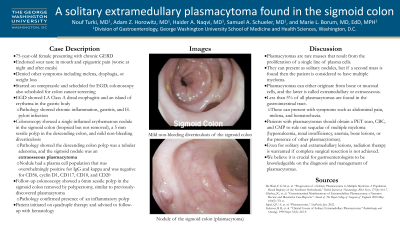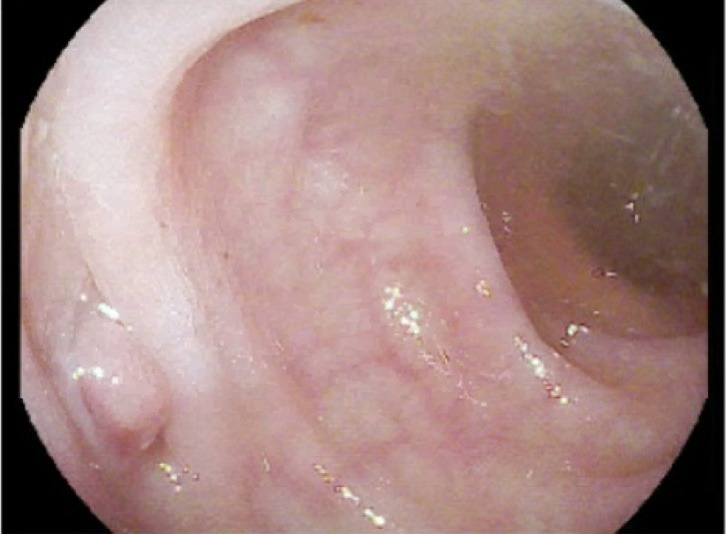Back


Poster Session A - Sunday Afternoon
Category: Colon
A0115 - A Solitary Extramedullary Plasmacytoma Found in the Sigmoid Colon
Sunday, October 23, 2022
5:00 PM – 7:00 PM ET
Location: Crown Ballroom

Has Audio

Nouf Turki, MD
George Washington University Hospital
Washington, DC
Presenting Author(s)
Nouf Turki, MD1, Adam Horowitz, MD2, Haider Abbas Naqvi, MD3, Samuel A. Schueler, MD4, Marie L. Borum, MD, EdD, MPH4
1George Washington University Hospital, Washington, DC; 2George Washington University Hospital, Washington, VA; 3MedStar Health, Baltimore, MD; 4George Washington University, Washington, DC
Introduction: Plasmacytomas are rare tumors made of a single line of plasma cells that can appear anywhere in the body, but the majority arise in the bone marrow. Extramedullary plasmacytomas (EMPs) represent less than 5% of cases, and only 5% of EMPs occur in the gastrointestinal (GI) tract. GI EMPs occur most commonly in the small intestine, followed by the stomach; colonic EMPs are rare. We present a case of a solitary extramedullary plasmacytoma found in the sigmoid colon on routine colonoscopy.
Case Description/Methods: A 75-year-old female with a history of hypertension and diabetes presented for evaluation of sour taste in her mouth and epigastric pain, and also for average-risk colorectal cancer screening. Esophagogastroduodenoscopy showed Los Angeles Classification grade A esophagitis and patchy gastric erythema with Helicobacter pylori infection confirmed from random gastric biopsies. Colonoscopy showed an erythematous nodule in the sigmoid colon, and polypectomy was performed (Figure 1). Pathology showed plasma cell population with immunostaining that was overwhelmingly positive for IgG and kappa consistent with extraosseous plasmacytoma. A repeat colonoscopy was performed in four months which confirmed complete removal of the plasmacytoma. The patient was referred to a hematologist with evaluation pending.
Discussion: Colonic EMPs are rare. Patients can either be asymptomatic or present with abdominal pain, melena, and hematochezia. Once confirmed on pathology, patients should undergo extensive work-up including a complete blood count, comprehensive metabolic panel, and positron emission tomography to assess for more extensive involvement. Radiation therapy is warranted if complete surgical resection is not achieved, and these patients must be monitored closely for signs and symptoms of multiple myeloma. It is crucial for gastroenterologists to understand the significance of this rare finding to facilitate a comprehensive evaluation.

Disclosures:
Nouf Turki, MD1, Adam Horowitz, MD2, Haider Abbas Naqvi, MD3, Samuel A. Schueler, MD4, Marie L. Borum, MD, EdD, MPH4. A0115 - A Solitary Extramedullary Plasmacytoma Found in the Sigmoid Colon, ACG 2022 Annual Scientific Meeting Abstracts. Charlotte, NC: American College of Gastroenterology.
1George Washington University Hospital, Washington, DC; 2George Washington University Hospital, Washington, VA; 3MedStar Health, Baltimore, MD; 4George Washington University, Washington, DC
Introduction: Plasmacytomas are rare tumors made of a single line of plasma cells that can appear anywhere in the body, but the majority arise in the bone marrow. Extramedullary plasmacytomas (EMPs) represent less than 5% of cases, and only 5% of EMPs occur in the gastrointestinal (GI) tract. GI EMPs occur most commonly in the small intestine, followed by the stomach; colonic EMPs are rare. We present a case of a solitary extramedullary plasmacytoma found in the sigmoid colon on routine colonoscopy.
Case Description/Methods: A 75-year-old female with a history of hypertension and diabetes presented for evaluation of sour taste in her mouth and epigastric pain, and also for average-risk colorectal cancer screening. Esophagogastroduodenoscopy showed Los Angeles Classification grade A esophagitis and patchy gastric erythema with Helicobacter pylori infection confirmed from random gastric biopsies. Colonoscopy showed an erythematous nodule in the sigmoid colon, and polypectomy was performed (Figure 1). Pathology showed plasma cell population with immunostaining that was overwhelmingly positive for IgG and kappa consistent with extraosseous plasmacytoma. A repeat colonoscopy was performed in four months which confirmed complete removal of the plasmacytoma. The patient was referred to a hematologist with evaluation pending.
Discussion: Colonic EMPs are rare. Patients can either be asymptomatic or present with abdominal pain, melena, and hematochezia. Once confirmed on pathology, patients should undergo extensive work-up including a complete blood count, comprehensive metabolic panel, and positron emission tomography to assess for more extensive involvement. Radiation therapy is warranted if complete surgical resection is not achieved, and these patients must be monitored closely for signs and symptoms of multiple myeloma. It is crucial for gastroenterologists to understand the significance of this rare finding to facilitate a comprehensive evaluation.

Figure: An erythematous nodule in the sigmoid colon
Disclosures:
Nouf Turki indicated no relevant financial relationships.
Adam Horowitz indicated no relevant financial relationships.
Haider Abbas Naqvi indicated no relevant financial relationships.
Samuel Schueler indicated no relevant financial relationships.
Marie Borum: Takeda – Advisory Committee/Board Member.
Nouf Turki, MD1, Adam Horowitz, MD2, Haider Abbas Naqvi, MD3, Samuel A. Schueler, MD4, Marie L. Borum, MD, EdD, MPH4. A0115 - A Solitary Extramedullary Plasmacytoma Found in the Sigmoid Colon, ACG 2022 Annual Scientific Meeting Abstracts. Charlotte, NC: American College of Gastroenterology.
